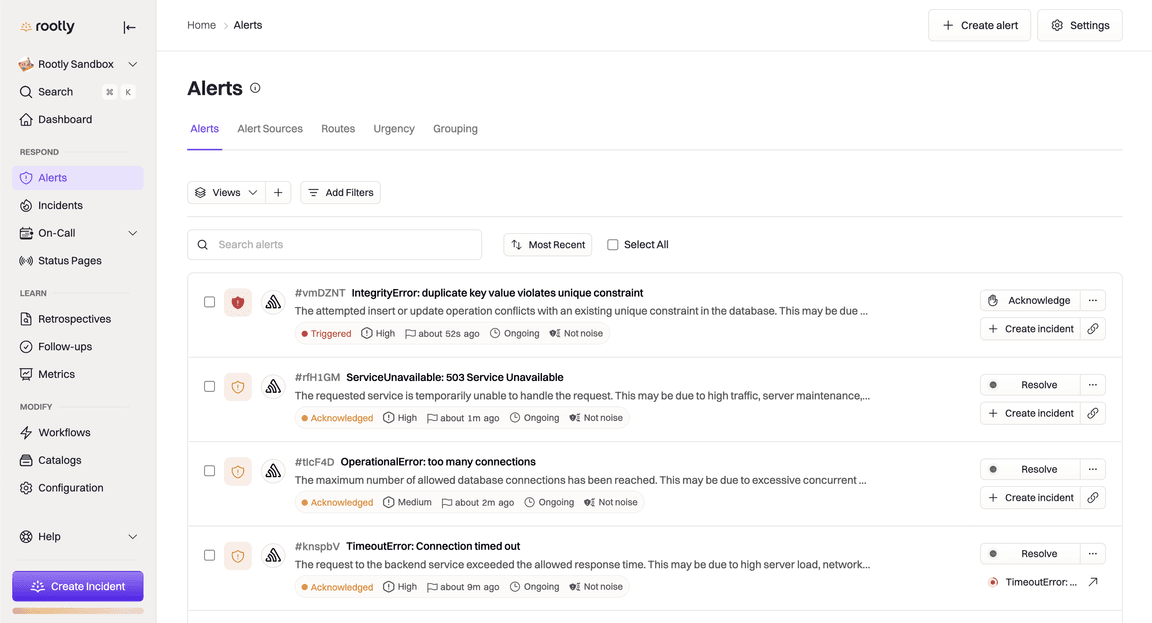Key Results
- Directly avoid a negative impact on Annual Recurring Revenue (ARR) of >$100,000+
- Improve Mean Time To Resolution (MTTR) for errors by 50%
- Increase the happiness of their own development team
SDK
Ruby (Sidekiq, Rails), Flutter, JavaScript
Solutions
Error Monitoring, Performance Monitoring, Alerts
The reliability platform that relies on Sentry—how Rootly reduces MTTR by 50%
Rootly is the AI-native on-call and incident response platform that provides proactive support to help Site Reliability Engineers resolve incidents faster, improve system resilience, and streamline on-call operations.
Rootly, a rising name in application reliability that serves hundreds of customers ranging from startups to Fortune 500’s, knows firsthand the importance of a stable, trustworthy platform—one their users can count on for timely notifications and critical incident response. To make that happen, their engineering team relies on Sentry, integrating it deeply into their own alerting platform as a key tool in their stack.
By adopting Sentry, Rootly was able to:
- Directly avoid a negative impact on Annual Recurring Revenue (ARR) of >$100,000+, thanks to detecting and mitigating errors before they could impact users and poison their experience
- Improve Mean Time To Resolution (MTTR) for errors by 50%, which is critical to mitigate the impact of errors, reduce business impact for themselves and their users, and protect revenue.
- Increase the happiness of their own development team, making engineers more productive, reducing attrition, and simplifying the hiring and onboarding process.
We’re a reliability platform, and our reliability starts with Sentry.
JJ Tang, Rootly CEO and co-founder.
Choosing Sentry from day 1: full-stack observability for a dispersed team
From the start, Rootly knew they needed an observability solution that could keep up with their fast-paced, CI/CD-driven development. They required deep visibility across their entire stack–from the cloud-based backend, to the web and mobile frontends–to catch issues early, trace them to the exact commit, and roll back quickly, without slowing down their development team.
We deploy 10-20 times a day—only possible with Sentry pinpointing issues down to the commit and broken line of code. Instead of hours, fixes take minutes, keeping our team shipping without delays.
Dan Sadler, VP of Engineering
Rootly’s engineering leadership was already familiar with Sentry, having used it at previous companies. So when it came time to choose tools for their own platform, the decision was easy. For Dan Sadler, VP of Engineering, Sentry was the obvious choice: “Without clear information and context, you don’t know where to look—you’re operating in the dark. Context is critical to resolving incidents quickly and confidently, especially when you’re on-call.
Sentry provided real-time error detection, the context needed to get to the root cause fast, and an intuitive interface that is developer-friendly with a minimal learning curve and straightforward instrumentation.
By implementing Sentry from day one, Rootly ensured their globally-dispersed engineering team could stay productive and focused on building their platform, instead of wasting time reproducing and debugging issues.
Reducing MTTR by 50% and protecting revenue
Rootly uses Sentry across its backend applications (a Ruby on Rails monolith, including several serverless compute functions, deployed across AWS and GCP clouds) and web-based frontend. They’re also in the process of instrumenting their mobile apps. According to Dan Sadler, integrating Sentry was “super easy”—just like adding tags to issues.
Tags, which are automatically applied based on where an issue occurs in the application, help Rootly distinguish between business-critical and informational events in Sentry.
Business-critical errors require immediate action as they impact availability and revenue. For example, if Rootly fails to attach metadata to a user’s incident, it triggers a cascade of failures downstream, significantly affecting the user experience. These errors are surfaced to on-call engineers via Rootly’s On-Call app, which ingests data from Sentry and intelligently pages the right team or developer. With Sentry’s context, the team can pinpoint the commit that caused the issue and quickly revert it to restore functionality.
Sentry has directly protected our revenue by mitigating errors before they impact users—keeping them happy and our top line intact. We estimate it has saved us hundreds of thousands in potential ARR damage.
JJ Tang, CEO and co-founder
Beyond critical issues, Sentry also helps with lower-priority errors. “These may not require an urgent page, but they’re still things we need to know about,” says Sadler. Rootly holds a weekly meeting to review all issues, regardless of severity, using Sentry’s visibility to identify opportunities to improve the overall reliability of the platform. “With Sentry, we have the knowledge to prioritize work and make sure we’re addressing the right things to improve platform reliability and eliminate issues impacting users”. Rootly uses tags and metadata to categorize issues by severity, service, deployment version, and relevant feature flags, and pinpoint patterns and regressions. They also track affected users to get insights on the real-world impact, and use session details and API response times to prioritize fixes.
Rootly developers <3 Sentry
Now that Sentry has grown alongside the Rootly engineering team, Sadler explains that every incident starts with a developer asking, ‘Is there a Sentry for this?’—referring to a Sentry Issue with a name our marketing team made sure we included; after all, it’s not every day your company name becomes a noun.
According to Sadler, issues that start from Sentry have a 50% lower MTTR than those reported in other ways. In Sadler’s words, when an error has a Sentry, “it’s connected to source code; it probably has a stack trace and relevant logs; it’s bringing in data from other sources… there’s all these things that add up to a rich alert.” For example, Rootly enriches alerts with affected customer segments, API failure rates, and whether the issue is causing widespread degradation. Alerts link to related errors, upstream and downstream dependencies, and correlated events across services. Sadler concludes: “Therefore, when the on-call engineer receives the alert, it is actionable: they know exactly what to do, regardless of whether we have a runbook for it or not.”
As the CEO of the company, Tang recognizes another benefit of standardizing on Sentry. “Sentry is an underrated recruiting advantage. Many developers already know and trust it, so they can start solving problems right away instead of learning a new tool. And if they haven’t used Sentry before? They learn to love it fast.”
Sentry keeps our team happy and has even helped us close candidates. Its low barrier to entry and intuitive interface make all the difference, especially during incidents, when every second counts.
JJ Tang
Sadler also sees Sentry’s impact on the bottom line. In Sadler’s words, “compared with alternatives, traditional observability platforms built around log collection and analysis cost significantly more. Sentry gives us the visibility we need without the hefty price tag.”

Prioritizing the best tools over all-in-one trade-offs
Sentry isn’t just a tool for Rootly—it’s a cornerstone of their reliability strategy. From leadership to engineers, the team depends on Sentry to catch errors early, reduce MTTR, and keep their platform stable for customers.
By integrating Sentry, Rootly has:
- Improved reliability by surfacing and resolving both critical and informational errors faster.
- Protected revenue by preventing costly incidents before they impact users.
- Boosted developer productivity with better debugging context, reducing frustration and churn.
- Simplified hiring and onboarding by using a tool engineers already know and trust.
- Saved money compared to traditional observability platforms.
It’s no surprise that Sentry is one of the most-used integrations in Rootly—not just for their team, but for their users too.
Tang and Sadler reflect on the years with Sentry and the impact it has had on the team: “Sentry is a best-of-breed, purpose-built tool for developers to debug issues in their code. We’re not going to compromise developer experience just to consolidate observability—especially when there’s no additional operational overhead and it’s actually more cost-effective than traditional alternatives. Why wouldn’t we choose the best tool for the job?”
Already a Rootly user?
Sentry is one of the most popular alert sources in Rootly. Sentry Issues is conveniently integrated with the Rootly incident management platform, allowing the creation of incidents from Sentry alerts automatically, just like the Rootly development team set up for themselves.
